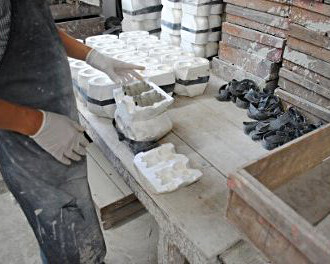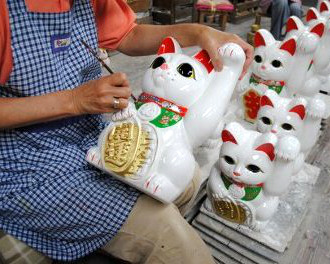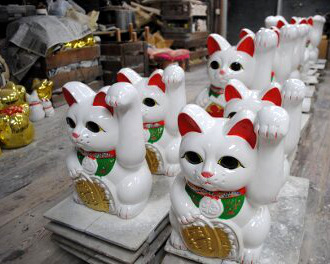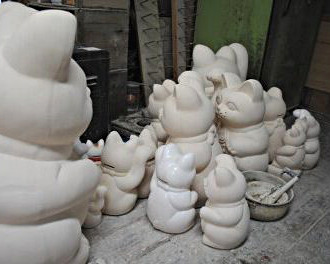Worldwide Shipping! Secure payment
No products
Product successfully added to your shopping cart
There are 0 items in your cart. There is 1 item in your cart.
Maneki Neko
There are 14 products.Gamagucci Neko
Dimensions: 19,5 cm (width) x 16 cm (depth) x 21 cm (height) (7.7in x 6.2in x 8.3in) Made by the craftmen in Shibaraki, Japan.
¥4,400Fukuzukushi Neko
Height: H15cm x 11.5cm ( H5.9in x 4.3in )Made of ceramicMade and hand-painted in Japan
¥2,400Warashi Neko
A0508-01-0005Dimensions:11cm x 13.5cm x 12.5cm4.3in x 5.3in x 4.9inAroma Burner made in Tokoname, Japan
¥2,940Ippuku Neko Incense Holder
A0508-10-0003Dimensions: ø10cm x H5cm / ø3.9in x H2in Made in Japan
¥1,625Neko Chopsticks Holder
A0512-07-0011Dimensions: 5cm / 2.4in Chopsticks holder made of ceramic in Japan.
¥490Maneki Neko & Kokeshi Erasers Iwako
Size : Maneki Neko - 3.3 cm (1.3inch)/ Kokeshi - 4.2 cm (1.7inch) Two different designs for the maneki neko erasersUnsuitable for children under 3 yearsNo toxic substancesMade in Japan
¥450Maneki Neko Iwako Eraser
Size : 3.3 cm (1.3inch)Unsuitable for children under 3 yearsNo toxic substancesMade in Japan
¥125Furoshiki Maneki Neko Shogatsu
Dimensions: 50 x 50 cm (19,7 x 19,7in)Material: 100% cottonMade in Japan
¥900Furoshiki Maneki Neko Naru
Dimension: 50 x 50 cm (19,7 x 19,7in)Material : 100 % cottonMade in Japan
¥900Animals Plants Peropon
Dimensions: 7,6cm (height) x 7cm (width) x 10,5cm (depth) (2.9 in x 2.7 in x 4.1) Material: ceramic Animals: dog, panda, frog, cat Made in Japan
¥1,450Tenugui Maneki Oyako
Dimensions: 100 x 35 cm (39.4 x 13.8in) Material: 100% cotton Made in Japan
¥1,250
A Manekineko, also called 'lucky cat' or 'good fortune cat' in Western countries, is a bobtail statue traditionally made of ceramic in Japan.
You can meet them very often in restaurants and shops and also in Japanese homes as a welcoming decoration.
Their origin is uncertain but they seem to have appeared during Edo period (1600-1868).
All our Mane...
A Manekineko, also called 'lucky cat' or 'good fortune cat' in Western countries, is a bobtail statue traditionally made of ceramic in Japan.
You can meet them very often in restaurants and shops and also in Japanese homes as a welcoming decoration.
Their origin is uncertain but they seem to have appeared during Edo period (1600-1868).
All our Maneki Neko are made and hand painted with great care in Japan, near Nagoya city.
Which paw?
In Japan, models waving with the right paw are traditionally supposed to bring money and luck and those waving with the left paw are supposed to bring people or customers.
What color?
The original model is the tricolor one (white with spots) who represents the Japanese bobtail in its most common color.
There are also other versions such as the black Maneki Neko whose function is to repel evil spirits and bad luck and the gold one which suppose to bring wealth to its owner.
Traditional models usually wear a necklace with a bell and a koban (a gold coin from Edo period). The inscription on the coin means ten million ryo (another currency of the same period).
Origins
There are many legends describing the origin of those statues. According to some sources they might come from the Osaka region, while others say they come from Edo (old Tokyo). Today many of the ceramic models are made in Seto and Tokoname.
The most famous story describes how an old woman with no money and out of desperation was forced to sell her cat. Shortly after, one night, she had a dream in which her former companion appeared and asked her to make a statue of him. Troubled by this experience she followed the advice and made a representation of her cat in clay. Soon after, someone came by and offered to buy her statue. She then made a few other ones and again it was an immediate success. She kept doing and it worked so well that she quickly became very rich.
Another story describes how an emperor avoided a trap set by his opponents thanks to a cat beckoning with his paw. Attracted by the amazing attitude of the animal, he went away from his original road and was saved from death. This story is one that is presented as an explanation for the original gesture of these lucky charms.
Manufacturing




The statues are first shaped using molds and then dried for a week or more depending on the conditions (temperature, humidity...) and the size of the objects.
They are then placed in a large oven in which the ceramic will harden and get its final finish. Usually the oven starts only when it is full.
The Maneki Neko are then polished and hand-painted.
Golden models go through a second baking step which stabilizes the color. Because of this second cooking process they are slightly smaller than the other ones.
We assure you the best wrapping and packing for your fragile items. Do not hesitate to contact us if you have any question.
Less
